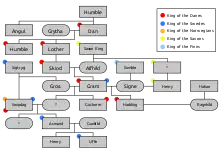| Svipdagr | |
|---|---|
| King of the Norwegians | |
| King of the Swedes | |
| Predecessor | Gram |
| Successor | Asmund |
| King of the Danes (first reign) | |
| Predecessor | Gram |
| Successor | Guthorm |
| King of the Danes (second reign) | |
| Predecessor | Guthorm |
| Successor | Hading |
| Consort | daughter of Gram and Groa |
| Issue | daughter Asmund |
| Father | Sigtryg |
| Religion | Pagan |
| Characters of Gesta Danorum |
|---|
 |
| Danish kings |
| Foreign rulers |
| Other men |
| Women |
Svipdagr or Swipdag was a legendary Swedish king and important figure in Book One of Gesta Danorum. The realm of his father was invaded by a Danish prince, Gram in to order marry, Svipdagr's sister, Groa. The prince was eventually successful and Svipdagr's father, Sigtryg was killed. Svipdagr escaped to Norway and carved himself a kingdom of his own. Later, Gram's act to dishonor his wife compelled Svipdagr to invade Sweden. After Gram murdered the King of the Saxons many Saxons joined Svipdagr's side. The war continued many years and during this time Gram tried to rape Svipdagr's daughter. Finally, Svipdagr was able to kill Gram in battle and took over Sweden and Denmark.[1][2]
Having won the war, Svipdagr installed his nephew, Guthorm as the puppet king of the Danes, while Guthorm's half-brother, Hading entered exile, but eventually returned and killed Svipdagr, leaving his son, Asmund to continue the war.[3]
The text
| Gesta Danorum, Book One |
|---|
| But, while much busied with a war against Norway, which he had taken up against King Swipdag for debauching his sister and his daughter, he heard from a messenger that Signe had, by Sumble's treachery, been promised in marriage to Henry, King of Saxony. |
| After this SWIPDAG, King of Norway, destroyed Gram, who was attempting to avenge the outrage on his sister and the attempt on his daughter's chastity. This battle was notable for the presence of the Saxon forces, who were incited to help Swipdag, not so much by love of him, as by desire to avenge Henry. |
| GUTHORM and HADDING, the son of Gram (Groa being the mother of the first and Signe of the second), were sent over to Sweden in a ship by their foster-father, Brage (Swipdag being now master of Denmark), and put in charge of the giants Wagnhofde and Hafle, for guard as well as rearing. |
| Swipdag, now that he had slain Gram, was enriched with the realms of Denmark and Sweden; and because of the frequent importunities of his wife he brought back from banishment her brother Guthorm, upon his promising tribute, and made him ruler of the Danes. But Hadding preferred to avenge his father rather than take a boon from his foe. |
| After this he prevailed over a great force of men of the East, and came back to Sweden. Swipdag met him with a great fleet off Gottland; but Hadding attacked and destroyed him. And thus he advanced to a lofty pitch of renown, not only by the fruits of foreign spoil, but by the trophies of his vengeance for his brother and his father. And he exchanged exile for royalty, for he became king of his own land as soon as he regained it. |
| Meanwhile, Asmund, the son of Swipdag, fought with Hadding to avenge his father. |
References
- ↑ The Danish History, Book One.
- ↑ "Peter A. Munch. Norse Mythology: Legends of Gods and Heroes – The Gold Scales". oaks.nvg.org.
- ↑ Pulsiano, Phillip; Wolf, Kirsten (2017). Routledge Revivals: Medieval Scandinavia (1993): An Encyclopedia. Routledge. ISBN 9781351665018.